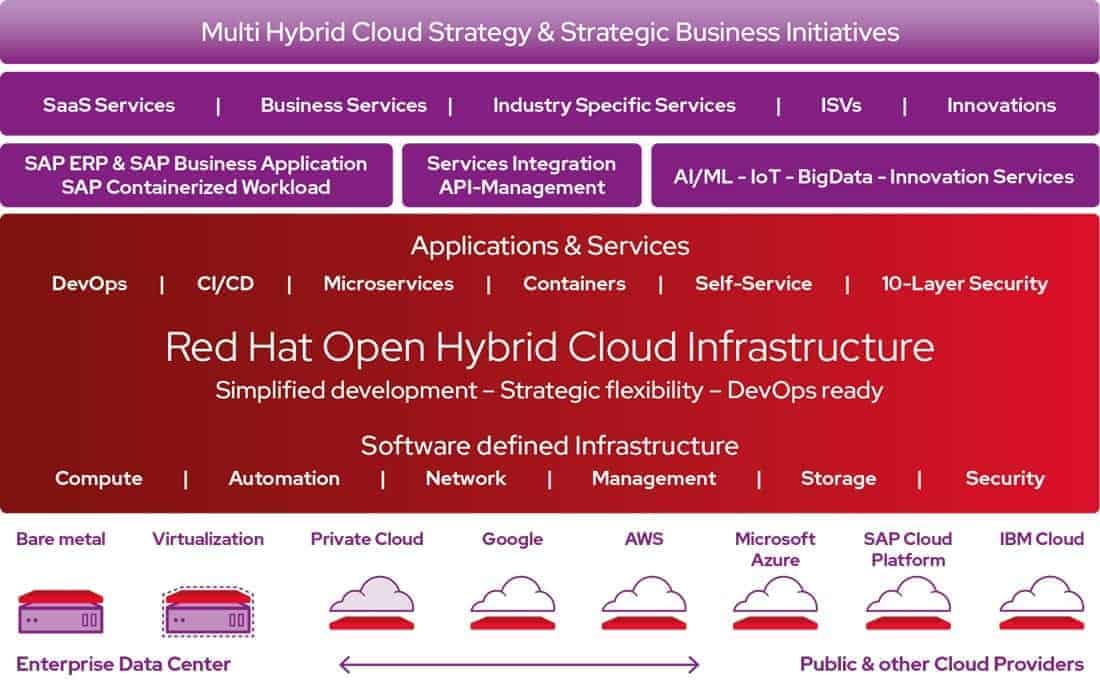The path has the goal of "digital excellence


All S/4 Hana steps are closely linked to decisions for the IT infrastructure and new, hybrid architectures. SAP is increasingly relying on open source technologies for the latest product generations, such as Linux for Hana or Kubernetes for SAP Data Hub.
For companies, this raises the question of which partner can best support them in the introduction of open source into corporate IT.
"By 2025" may still sound like a very long time, but time could still be running out for companies. Not only could the necessary resources of developers be lacking, but unforeseen delays in implementation are the rule rather than the exception for large IT projects.
And as part of their strategic reorientation, numerous companies are likely to discover that IT structures have become increasingly complex and confusing, especially in recent years.
They were modernized and expanded in many subareas as needed, but lost their future security to the same extent due to the increasing number of implemented solutions.
Digital transformation
The other challenge that will affect all companies in the coming years is digital transformation. The transformation, which has been much talked about for years, involves a large number of new issues that will have to be taken into account by all companies in the medium term in the interests of competitiveness.
These include artificial intelligence and machine learning, or data-driven processes that enable a better understanding of customer needs, for example.
Other important topics are Industry 4.0, IoT, RPA, Blockchain or Virtual and Augmented Reality. These modern applications are developed cloud-native today.
Containerization, Kubernetes and cloud platforms are the basis. One solution lies in the abstraction of the infrastructure through an additional layer.
It relies on Red Hat OpenShift - an enterprise Kubernetes platform that allows unified, cloud-native application development on any infrastructure, a hybrid multi-cloud mix including on-prem deployments.
It is precisely these properties that predestine the use of Open Hybrid Cloud Infrastructure in the context of SAP integration. Existing SAP customers retain permanent freedom of choice with regard to their platform.
Legacy IT vs. innovation
A major challenge for companies, especially large corporations with legacy IT that has grown over the years, is to link and closely integrate the SAP world on the one hand with innovation topics on the other.
Red Hat has been able to offer solutions here for many years that go far beyond an enterprise Linux system and support integration of different applications. This results in valuable synergies for companies that represent significant added value.
One example is the Ansible project, an automation language and framework for organizing and administering IT environments.
Following its acquisition by Red Hat, Ansible has become one of the largest open source projects in the world. It is a powerful tool that helps companies and especially partners to achieve significantly more efficiency in installation processes.

SAP and Open Source
In addition, solutions from Red Hat are also increasingly coming into focus because SAP itself has been increasingly going the open source route for some time and has been relying on container-based workload strategies, for example.
For example, SAP is committed to developing open source projects that are suitable for enterprise use and based on open standards. Like other software manufacturers, SAP uses the innovation potential of open source and has, for example, developed the in-memory database Hana and SAP Vora with technologies such as Linux and containers.
Containerization of services and SAP's use of Kubernetes clusters inevitably lead to the Red Hat OpenShift Kubernetes container platform, which is certified for SAP Data Hub. Thus, there is an increasing desire among SAP users to use OpenShift as the basis for processing the SAP workload.
Ansible Automation and OpenShift
Ansible and OpenShift also illustrate Red Hat's special position in the SAP ecosystem. Red Hat is not only a technology provider for end customers, but also an important service provider for SAP partners.
With Red Hat's support, partners can offer additional services to their customers. For example, an SAP partner performing Hana migrations can benefit from Red Hat in areas of innovation such as AI, machine learning, IoT, Big Data, or blockchain.
Not only end customers, but also partners receive the frameworks and methodologies as well as individual "building blocks" and applications to offer new services and cover innovation topics.
Red Hat creates value for enterprises by combining simple, integrated development flexibility in IT strategy and a modern IT culture.
Red Hat's global open hybrid cloud strategy corresponds with SAP's orientation and - representative of the ecosystem of all partners - also with that of IBM.
The solutions that Red Hat provides to customers live from the basic idea of far-reaching integration. They address the widespread problem of IT and data silos.
As part of its service package, Red Hat offers companies fit-to-strategy solutions and technologies. When it comes to integration, the modernization of interfaces proves to be difficult on the one hand, but on the other hand also the large number of proprietary developments, for example around supply chain, production or materials management. They are often based on the proprietary programming language Abap.
Public Cloud and Shadow IT
Migrating applications is complicated because S/4 is based on a different database technology. So what is to be done: Develop new applications or adapt them? This question arises in many companies in view of the IT structures around the SAP infrastructure that have grown over the years.
In some cases, this dilemma is countered with the use of SaaS solutions, often relying on common public cloud offerings, which leads to the creation of shadow IT.
Not infrequently, this approach was and is tolerated by management because certain cloud offerings such as test environments or redundancies for peaks could not or cannot be mapped from the existing IT.
But it's the resulting IT silos that are holding companies back from true disruption and innovation - and from using cloud services to make their IT infrastructure flexible and progressive.
Integration, as Red Hat understands it, can ensure that disparate systems are connected. It also leads to the elimination of media discontinuities.
If you ask IT managers in companies, there are still numerous processes that are less automated than they could be. What is needed to overcome the existing silos in companies is a uniform and modern technical basis that helps to connect all existing applications and services.
Open application programming interfaces (APIs), which form the basis for networking data, applications and devices, make a decisive contribution to this.
Red Hat's concept of so-called Side-by-Side Extensibility connects SAP data, processes and UI with state-of-the-art programming environments, CI/CD and DevOps based on Red Hat OpenShift - uniformly and scalable on any infrastructure.
Open Hybrid Cloud
Data is known to be "the new oil" and data-driven practices will help IT intelligence-based companies make better decisions in the future.
On an open hybrid cloud infrastructure, solutions can be developed and scaled globally that, depending on the data situation, provide behavior-based and high-performance support using artificial intelligence and machine learning methods, for example in the automated individualization of offers.
The prerequisite is that operational data and experience data are not only collected and collated, but also merged, especially in real time with data from SAP instances.
In the future, we will have to see maximum flexibility in the execution and design of services - in addition to the classic on-prem execution in the data center, it will be possible to outsource applications to the public or private cloud or to transfer them to a hybrid operation thanks to modern containerization.
In these cases, the company benefits from the flexibility to add resources at the push of a button or on a rule-based and automated basis. Flexibility is absolutely essential, especially in view of the current, specific customer challenges.
According to Red Hat's general assessment and experience, 70 percent of enterprise IT efforts are related to traditional workloads, 20 percent to brownfield projects such as migrations and modernizations through containerization, and 10 percent to innovations such as cloud-native developments. Red Hat is one of the few companies with more than 25 years of experience in all three areas.
However, it is also clear that most SAP customers will operate a hybrid cloud in the coming years. In the future, they will obtain some of their current applications from SAP as SaaS and the remaining applications will be migrated to S/4.
This inevitably increases complexity, and selecting the right toolset for delivering end-to-end services in hybrid environments is crucial. Here, too, there is no way around open source-based platforms.
Together: SAP, Red Hat and IBM
In general, the hybrid cloud trend is unstoppable, and so Red Hat, SAP and - representing all Red Hat partners - IBM are pursuing a joint strategy.
It is technically and methodologically based on Red Hat's open source solutions and years of experience in supporting and modernizing traditional workloads. The key is abstraction towards application services and towards any infrastructure.
The advantages of open source software are well known by now, but it should also be clear that equating it with "everything for free" falls short. Open source does not mean that you can use everything without problems and without the need for appropriate administration and customization.
In addition, especially in the Linux environment, there are several patches and enhancements per year that need to be applied and adapted - a task that Red Hat, as an experienced partner, takes on for companies in the form of comprehensive patch management.
For example, the company operates a service that manages its own infrastructure elements, globally monitors all important alerts, and delivers or recommends the appropriate patches accordingly.
Thousands of hardware, software, and security certifications of Red Hat Enterprise Linux are also fully valid for use as the basis for an SAP platform.
Kubernetes:
How companies solve the new challenge
Kubernetes is one of the most important topics of the future. But many executives have yet to come to terms with the thought patterns behind it; after all, Kubernetes use also affects mission-critical applications.
Red Hat, for example, has published a white paper on the specific challenges of container security that is available for free download (Ten Layers of Container Security).
Red Hat Innovation Lab:
Get to know DevOps and agility
For many large corporations, a DevOps corporate culture can lead to a real culture shock, because the old familiar development philosophy seems ill-suited to it.
Therefore, Red Hat has created a new project form with the Open Innovation Labs, which goes far beyond a classic chemistry meeting at the beginning of the project:
This is an offer in which a concrete use case is extracted from a project task and in which concrete results are developed for the commissioning company over the course of six to twelve weeks.
In this way, Red Hat imparts the know-how and strategies that a company needs for independent project implementation. The customer should be enabled to implement complex solutions themselves using agile methods (Scrum, Design Thinking, etc.).
Professionals and managers who want to get to grips with DevOps, the combination of development and operations, and find out how they can prepare their team for this innovative form of work, can find out more at https://www.redhat.com/de/topics/devops#? numerous videos and further information.






